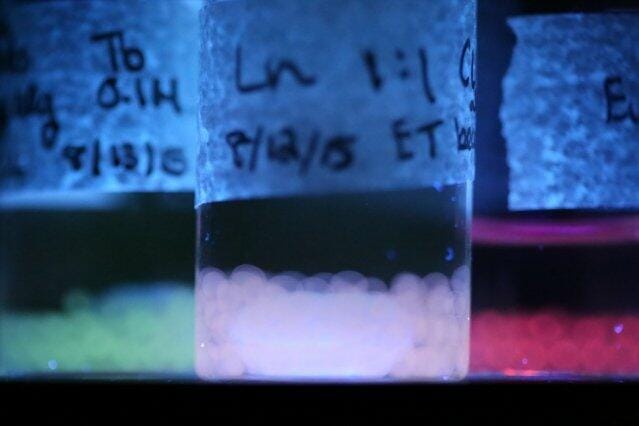Mussel Inspired Tunable Fluorescent Metallic Gels Could Create New Biological Detectors

The ever preoccupied researchers at MIT are reporting a new family of light emitting materials that allow control of the wavelength. Potential uses could include as detectors to biological and chemical stimuli, not just an on and off state but sensitive and responsive to varying levels of changes.
The new material made from rare-earth materials is described in the Journal of American Chemical Society. Rare earth material from the lanthanide group are combined with a polymer called polyethylene glycol or PEG, producing a material that has the unique property allowing tuning of the frequency of the light. The light emissions are controlled by small changes in the environment that make the material to emit light with varying frequencies, based on that particular change. The bond dynamics between Lanthanide and PEG change leading to change in the light produced. The reference state can be changed to white to make it easier to differentiate from shades of green or even red.
Biomimicry Strikes Gold Again
Inspired from biomimicking mussels anchor bonds themselves to rocks using metal-coordination bonds. For those of you new to biomimicry, it is the science of creating materials and structures by studying and copying how nature has dealt with the same problems. Using nature’s tricks to design adhesive polymers, the researchers were able to create a new material.
While other researchers are looking into inspiration to squids for super strong materials and camouflage, these group of researchers lead by Dr. Niels Holten-Andersen at MIT are looking towards Mussels and Abalone’s for bioinspiration. Mussels have previously inspired super-strong surgical glue and polymer coatings. The bonds identified and applied here are very important biologically and also found in the bonds between oxygen and hemoglobin in our blood.
Potential Uses for These Metallic Gels
Some tests showed the use of this material to detect pollutants and pathogens in air and water. By engineering the material to respond to toxins, bacteria and viruses, just one test could replace multiple tests and instruments. It comes in gel form that can be applied as a thin film to surfaces where environmental stimuli need to be monitored. Other potential uses include applying to mechanical joints to monitor mechanical changes and stress in systems.
Only in situ uses have been defined by the researchers working on the project. We are hoping the same material is modified for invivo microscopic monitoring of cell’s internal reactions, working similar to the fluorescent on and off gene added to confirm edits in DNA.
Source: MIT
Also Check: Protective coatings on extensible biofibres, Control of hierarchical polymer mechanics with bioinspired metal-coordination dynamics


